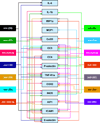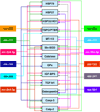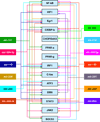All's well that transcribes well: non-coding RNAs and post-stroke brain damage
- PMID: 23954844
- PMCID: PMC3805745
- DOI: 10.1016/j.neuint.2013.07.014
All's well that transcribes well: non-coding RNAs and post-stroke brain damage
Abstract
The mammalian genome is replete with various classes of non-coding (nc) RNA genes. Many of them actively transcribe, and their relevance to CNS diseases is just beginning to be understood. CNS is one of the organs in the body that shows very high ncRNAs activity. Recent studies demonstrated that cerebral ischemia rapidly changes the expression profiles of different classes of ncRNAs: including microRNA, long noncoding RNA and piwi-interacting RNA. Several studies further showed that post-ischemic neuronal death and/or plasticity/regeneration can be altered by modulating specific microRNAs. These studies are of interest for therapeutic development as they may contribute to identifying new ncRNA targets that can be modulated to prevent secondary brain damage after stroke.
Keywords: Cerebral ischemia; Molecular mechanisms; Pathophysiology; Transcription; Translation; microRNA.
Copyright © 2013 Elsevier Ltd. All rights reserved.
Conflict of interest statement
Figures




Similar articles
-
Non-coding RNAs and neuroprotection after acute CNS injuries.Neurochem Int. 2017 Dec;111:12-22. doi: 10.1016/j.neuint.2017.01.015. Epub 2017 Jan 26. Neurochem Int. 2017. PMID: 28131900 Free PMC article. Review.
-
Non-coding RNAs in cerebral endothelial pathophysiology: emerging roles in stroke.Neurochem Int. 2014 Nov;77:9-16. doi: 10.1016/j.neuint.2014.03.013. Epub 2014 Apr 3. Neurochem Int. 2014. PMID: 24704794 Free PMC article. Review.
-
Noncoding RNAs in ischemic stroke: time to translate.Ann N Y Acad Sci. 2018 Jun;1421(1):19-36. doi: 10.1111/nyas.13612. Epub 2018 Apr 23. Ann N Y Acad Sci. 2018. PMID: 29683506 Review.
-
Non-coding RNAs in Ischemic Stroke: Roles in the Neuroinflammation and Cell Death.Neurotox Res. 2020 Oct;38(3):564-578. doi: 10.1007/s12640-020-00236-7. Epub 2020 Jun 23. Neurotox Res. 2020. PMID: 32578041 Review.
-
Non-Coding RNA in Acute Ischemic Stroke: Mechanisms, Biomarkers and Therapeutic Targets.Cell Transplant. 2018 Dec;27(12):1763-1777. doi: 10.1177/0963689718806818. Epub 2018 Oct 26. Cell Transplant. 2018. PMID: 30362372 Free PMC article. Review.
Cited by
-
lncRNA C2dat2 facilitates autophagy and apoptosis via the miR-30d-5p/DDIT4/mTOR axis in cerebral ischemia-reperfusion injury.Aging (Albany NY). 2021 Apr 4;13(8):11315-11335. doi: 10.18632/aging.202824. Epub 2021 Apr 4. Aging (Albany NY). 2021. PMID: 33833132 Free PMC article.
-
MicroRNA-424 alleviates neurocyte injury by targeting PDCD4 in a cellular model of cerebral ischemic stroke.Exp Ther Med. 2021 Dec;22(6):1453. doi: 10.3892/etm.2021.10888. Epub 2021 Oct 15. Exp Ther Med. 2021. PMID: 34721695 Free PMC article.
-
The microRNA miR-21 conditions the brain to protect against ischemic and traumatic injuries.Cond Med. 2017 Dec;1(1):35-46. Epub 2017 Dec 15. Cond Med. 2017. PMID: 34268484 Free PMC article.
-
Altered long non-coding RNA transcriptomic profiles in brain microvascular endothelium after cerebral ischemia.Exp Neurol. 2016 Mar;277:162-170. doi: 10.1016/j.expneurol.2015.12.014. Epub 2015 Dec 31. Exp Neurol. 2016. PMID: 26746985 Free PMC article.
-
Emerging Biomarkers in Vascular Cognitive Impairment and Dementia: From Pathophysiological Pathways to Clinical Application.Int J Mol Sci. 2019 Jun 8;20(11):2812. doi: 10.3390/ijms20112812. Int J Mol Sci. 2019. PMID: 31181792 Free PMC article. Review.
References
-
- Adachi T, Nakanishi M, Otsuka Y, Nishimura K, Hirokawa G, Goto Y, Nonogi H, Iwai N. Plasma microRNA 499 as a biomarker of acute myocardial infarction. Clinical chemistry. 2010;56:1183–1185. - PubMed
-
- Ambros V. The functions of animal microRNAs. Nature. 2004;431:350–355. - PubMed
-
- Baker WH, Howard VJ, Howard G, Toole JF. Effect of contralateral occlusion on long-term efficacy of endarterectomy in the asymptomatic carotid atherosclerosis study (ACAS). ACAS Investigators. Stroke. 2000;31:2330–2334. - PubMed
Publication types
MeSH terms
Substances
Grants and funding
LinkOut - more resources
Full Text Sources
Other Literature Sources
Medical

